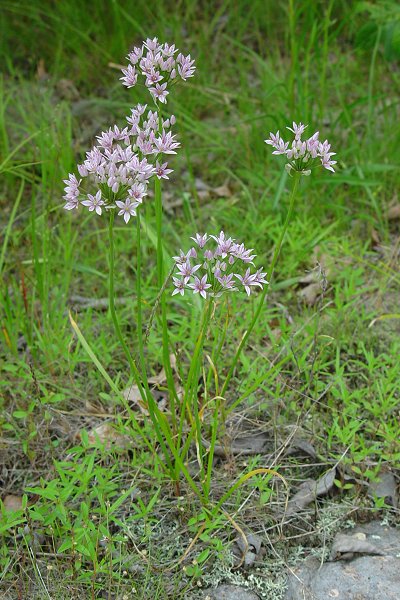Allium canadense L.
Wild Garlic

Native
CC = 2
CW = 3
MOC = 95
© DETenaglia
Allium canadense L.Wild Garlic | |
 |
Native CC = 2 CW = 3 MOC = 95 |
© DETenaglia |
|
Family - Liliaceae Habit - Perennial forb from a bulb. Stems - From a bulb. Bulb covered with a dense network of fibers, these tan in color. Bulb to 3 cm long, ovoid. Aerial stems to 40 cm tall, erect, glabrous, terete, single to multiple from the base, simple.
Leaves - Basal or nearly so, linear, flattened, glabrous, to 40 cm long, 2-7mm broad, with a broad shallow groove adaxially, sometimes folding at the base, pale green to whitish at the base. Stem and leaves with strong onion scent when bruised. Inflorescences - Terminal umbels. Flowers sometimes replaced by reddish bulblets, with inflorescences comprising any combination of flowers and bulblets. Bulblets sessile. Flowers with pedicels to 4 cm long, glabrous, erect. Pedicels much longer than the flowers. Bud of inflorescence covered with a scarious tan bract. Bract persistent at the base of the umbel after anthesis.
Flowers - Tepals 6, pink to white, glabrous, oblong-lanceolate, to 8 mm long, 3 mm broad. Stamens 6, erect. Filaments pinkish, glabrous, expanded at the base, adnate to the base of the tepals, 5 mm long. Ovary subglobose, glabrous, 3-locular. Style glabrous, 5 mm long, pinkish. Ovules 3-4 per locule.
Fruits - When produced, capsules 3-4 mm long, depressed-globose to broadly obovoid, 3-lobed, lacking triangular projections. Seeds black. Flowering - April - July. Habitat - Glades, bluffs, open woods, prairies, disturbed sites. Origin - Native to U.S. Other info. - This showy plant can be found throughout Missouri and most of the eastern half of the U.S. Like all of the state's native onions, it has flattened leaves. It is especially common in glade areas of the Ozarks. The plant has a strong onion scent and is edible. Cows which graze upon it produce onion-flavored milk. Photographs taken at Taum Sauk Mountain, MO., 5-31-03 (DETenaglia); also at St. Joe State Park, St. Francois County, MO, 6-2-2013 (SRTurner). |